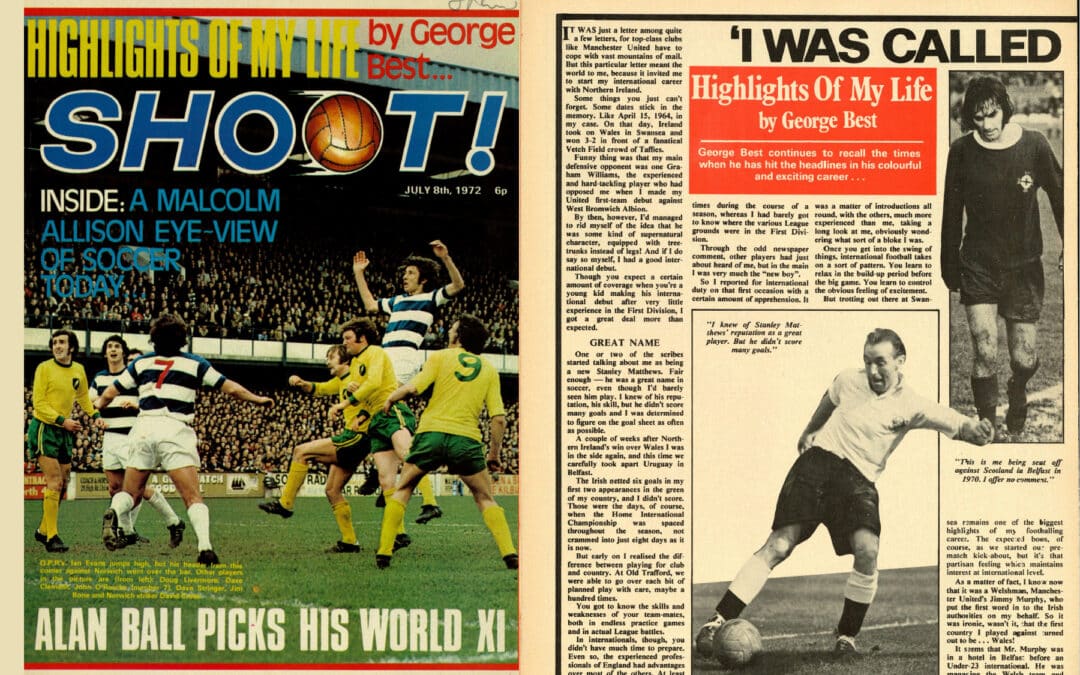Few football magazines have captured the hearts and minds of British football fans quite like Shoot. And few footballers have embodied the beautiful game’s artistry and controversy quite like George Best. When these two legends crossed paths in 1972, with Best appearing on Shoot’s iconic cover, it marked a pivotal moment in football history—one that perfectly encapsulated the spirit of an era when football was transforming from a working-class pastime into the global spectacle we know today.
This wasn’t just another magazine cover. It was a meeting of minds between Britain’s most beloved football publication and arguably the most gifted player ever to grace a football pitch. The timing was perfect: Shoot was establishing itself as the voice of football, whilst Best was at the height of his powers, mesmerising crowds with his sublime skills and making headlines both on and off the pitch.
The Rise of Shoot Magazine
Shoot Magazine launched in August 1969, arriving at a time when football was undergoing a cultural revolution. The magazine quickly distinguished itself from its competitors by offering something truly special: glossy colour photographs, in-depth player profiles, and most importantly, a genuine connection with the fans.
Within its first few years, Shoot had established several groundbreaking features that would define football journalism for decades. The magazine’s famous “Focus On” section provided fans with unprecedented access to their heroes, revealing not just their football credentials but their personal lives, favourite entertainers, and even their least favourite opponents. This intimate approach to sports journalism was revolutionary for its time.
The magazine’s circulation figures tell the story of its success. By 1996, Shoot was selling 120,000 copies per week, testament to its ability to capture the essence of football culture. Each edition featured a stunning two-page colour centrefold of a team, along with several other glossy colour photographs of players from the top divisions—a visual feast that brought the excitement of the pitch directly into readers’ homes.
George Best: The Beautiful Game’s Most Complex Star
By 1972, George Best had already established himself as one of football’s most extraordinary talents. The Northern Irish winger had burst onto the scene at Manchester United, combining pace, skill, and an almost supernatural ability to beat defenders with a flair that was both devastating and beautiful to watch.
Best’s playing style was poetry in motion. He possessed that rare combination of technical brilliance and physical prowess that allowed him to dominate games single-handedly. His dribbling was mesmerising, his shooting was deadly accurate, and his vision was second to none. He could score spectacular goals from impossible angles and create chances out of nothing.
But Best was more than just a footballer—he was a cultural icon. His good looks, fashionable dress sense, and glamorous lifestyle made him one of the first true football superstars. He dated models, opened boutiques, and lived a life that fascinated the media and the public alike. This combination of extraordinary talent and celebrity status made him the perfect subject for Shoot’s innovative approach to football journalism.
The Magic of the 1972 Cover Story
When George Best appeared on Shoot’s cover in 1972, the magazine was providing readers with something truly special. This wasn’t just a simple interview or photo shoot—it was an opportunity for Best to reflect on the unforgettable moments that had shaped his already dazzling career.
The timing was particularly significant. Best was still at the peak of his powers, having helped Manchester United win the First Division title and the European Cup just a few years earlier. His performances in those tournaments had been nothing short of magical, with his goal against Benfica in the 1968 European Cup final being one of many breathtaking moments that defined his career.
The Shoot feature allowed Best to reminisce about these career-defining moments. From his early days breaking through at Old Trafford to his performances on the European stage, the magazine gave readers unprecedented insight into the mind of a genius. It was the kind of intimate, personal journalism that Shoot had pioneered and that football fans craved.
Shoot’s Revolutionary Approach to Football Journalism
What made Shoot Magazine truly special was its understanding that football fans wanted more than just match reports and league tables. They wanted to feel connected to their heroes, to understand what made them tick, and to share in their triumphs and struggles.
The magazine’s “Star Writer” feature exemplified this approach. Each season, big-name First Division players would write columns about their football lives. The list of contributors read like a who’s who of football legends: Alan Ball, Billy Bremner, Kenny Dalglish, Kevin Keegan, Bryan Robson, and Charlie Nicholas all shared their thoughts and experiences with Shoot’s readers.
This personal touch extended to every aspect of the magazine. The famous Paul Trevillion “You Are The Ref” comic strip, which ran for many years, engaged readers by putting them in the shoes of match officials. It was interactive, educational, and entertaining—everything that Shoot represented.
The Cultural Impact of Football Magazines
The significance of George Best’s appearance on Shoot’s cover extends far beyond a simple magazine feature. It represented a crucial moment in the evolution of football culture, when the game was beginning to transcend its traditional boundaries and become a form of entertainment that could compete with music, films, and television.
Football magazines like Shoot played a crucial role in this transformation. They didn’t just report on football—they helped create football culture. By presenting players as personalities rather than just athletes, they helped establish the foundation for modern football’s celebrity culture.
The visual impact of Shoot’s colour photography cannot be overstated. At a time when television coverage was limited and most newspapers only used black and white photographs, Shoot’s glossy colour spreads brought the excitement and glamour of football to life in ways that had never been possible before.
The Legacy of That Historic Cover
The 1972 Shoot cover featuring George Best represents more than just a moment in magazine history—it symbolises the beginning of modern football culture. It showed how the beautiful game could be packaged, presented, and consumed in ways that went far beyond the traditional ninety minutes on a Saturday afternoon.
For George Best, the feature provided another platform to showcase not just his football skills but his personality and intelligence. It reinforced his status as football’s first true superstar and helped cement his legacy as one of the game’s most compelling figures.
For Shoot Magazine, featuring Best on their cover was both a statement of intent and a validation of their approach. It demonstrated that they had the credibility and the vision to attract the biggest names in football and to present them in ways that would resonate with fans.
The Enduring Appeal of Football Nostalgia
Today, The Magazine Archive has digitised Shoot’s extensive collection, making these historic issues available to a new generation of football fans. The archive runs from 1969 to 2008, preserving nearly four decades of football history and culture.
This digital preservation ensures that moments like George Best’s 1972 cover story remain accessible to fans who want to understand how football culture developed and evolved. It allows contemporary supporters to experience the excitement and anticipation that previous generations felt when they saw their heroes featured in the pages of Shoot.
The archive also serves as a valuable historical resource, documenting not just the development of football but the broader cultural changes that shaped British society during these crucial decades. Through Shoot’s pages, we can trace the evolution of football from a relatively simple spectator sport to the global phenomenon it has become.
Remembering the Legend
George Best’s career highlights are numerous and spectacular. His performances in the 1968 European Cup campaign, his incredible individual displays against some of Europe’s best teams, and his ability to single-handedly change the course of matches all contributed to his legendary status.
But perhaps what made Best truly special was his ability to make the impossible look effortless. His dribbling wasn’t just effective—it was beautiful. His goals weren’t just important—they were works of art. His very presence on the pitch elevated the game to levels that transcended sport and entered the realm of pure entertainment.
The 1972 Shoot cover captured Best at a moment when he was reflecting on these achievements and looking forward to future glories. It preserved a snapshot of a genius at work, providing insights into the mind of one of football’s most extraordinary talents.
Celebrating Football’s Golden Age
The meeting of George Best and Shoot Magazine in 1972 represents everything that was magical about football’s golden age. It was a time when the game was becoming more sophisticated and glamorous, yet still retained its authentic connection to the fans who loved it.
Shoot’s innovative approach to football journalism helped create the template for modern sports media, while George Best’s combination of skill and charisma established the blueprint for the modern football superstar. Together, they created moments that continue to inspire and entertain football fans more than fifty years later.
The historic 1972 cover remains a testament to the power of football to create lasting memories and to inspire generations of fans. Through The Magazine Archive’s digital collection, these memories live on, ensuring that the magic of that era continues to captivate and inspire new generations of football enthusiasts.
What’s your favourite George Best highlight? Share your memories with us below! ⬇️
https://www.themagazinearchive.com/shoot/

